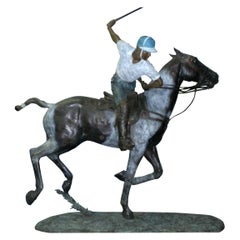William Behrends
Late 20th Century American Modern Statues
Bronze
People Also Browsed
Vintage 1920s Italian Art Deco Figurative Sculptures
Marble
Antique Early 1900s French Chinoiserie Armchairs
Velvet, Giltwood, Lacquer
Antique Late 19th Century Russian Paintings
Canvas
Antique Late 19th Century Italian Classical Roman Busts
Bronze
19th Century Old Masters Figurative Paintings
Canvas, Oil
1910s American Impressionist Landscape Paintings
Canvas, Oil
Antique Late 19th Century Scottish Victorian Decorative Art
Other
19th Century Old Masters Figurative Paintings
Oil
20th Century Neoclassical Arms, Armor and Weapons
Steel
Antique Mid-18th Century English Palladian Fireplaces and Mantels
Statuary Marble
Antique 19th Century Dutch Baroque Cabinets
Bone, Tortoise Shell, Ebony, Mahogany, Rosewood
1910s Figurative Paintings
Canvas, Oil
Antique Early 1900s Italian Art Nouveau Desks and Writing Tables
Bronze
Early 20th Century American Edwardian Inkwells
Sterling Silver, Bronze
Antique Early 19th Century French Renaissance Vases
Agate, Gold, Enamel, Silver
Antique 1880s French Urns
Porcelain
A Close Look at Modern Furniture
The late 19th and early 20th centuries saw sweeping social change and major scientific advances — both of which contributed to a new aesthetic: modernism. Rejecting the rigidity of Victorian artistic conventions, modernists sought a new means of expression. References to the natural world and ornate classical embellishments gave way to the sleek simplicity of the Machine Age. Architect Philip Johnson characterized the hallmarks of modernism as “machine-like simplicity, smoothness or surface [and] avoidance of ornament.”
Early practitioners of modernist design include the De Stijl (“The Style”) group, founded in the Netherlands in 1917, and the Bauhaus School, founded two years later in Germany.
Followers of both groups produced sleek, spare designs — many of which became icons of daily life in the 20th century. The modernists rejected both natural and historical references and relied primarily on industrial materials such as metal, glass, plywood, and, later, plastics. While Bauhaus principals Marcel Breuer and Ludwig Mies van der Rohe created furniture from mass-produced, chrome-plated steel, American visionaries like Charles and Ray Eames worked in materials as novel as molded plywood and fiberglass. Today, Breuer’s Wassily chair, Mies van der Rohe’s Barcelona chair — crafted with his romantic partner, designer Lilly Reich — and the Eames lounge chair are emblems of progressive design and vintage originals are prized cornerstones of collections.
It’s difficult to overstate the influence that modernism continues to wield over designers and architects — and equally difficult to overstate how revolutionary it was when it first appeared a century ago. But because modernist furniture designs are so simple, they can blend in seamlessly with just about any type of décor. Don’t overlook them.
Finding the Right Statues for You
Antique, new and vintage statues can bring depth and distinctive charm to your home’s interiors or your meticulously maintained outdoor garden area.
Introduce an assortment of textures and colors as well as a refreshing air of drama by decorating with stoic sculptural works in any living room, dining room or bedroom, no matter the size or shape of the statues you choose. You don’t have to haul a 19th-century life-size hand-carved work of Italian Carrara marble into your hallway unless, of course, that is the kind of decorative touch that your interior would benefit from. A large sculpture bust placed in your happy home office or positioned as a centerpiece on a table with other decorative objects in your foyer, for example, can prove welcoming to guests and invite rich conversation about your interests.
For a sculpture, an outdoor setting on a lawn or in a garden can open up a whole new world of beauty and meaning. While traditional stone cherub figures can promise tranquility, you can heighten the ogs/the-study/outdoor-dining-spaces/ target="_blank" rel="noopener noreferrer">experience of outdoor family meals or garden parties with provocative statues to help frame the dining area in your yard. Lend an air of permanence to the perimeter of your garden with a pair of bronze lion statues or use abstract works of metal to contrast the clean, geometric lines of your manicured shrubbery and thoughtful landscape design.
We know that your garden is an invaluable retreat for when you need some relaxation and that introducing art to your home’s interiors has innumerable benefits. On 1stDibs, find a wide variety of antique, new and vintage statues for all of your decorating needs.
